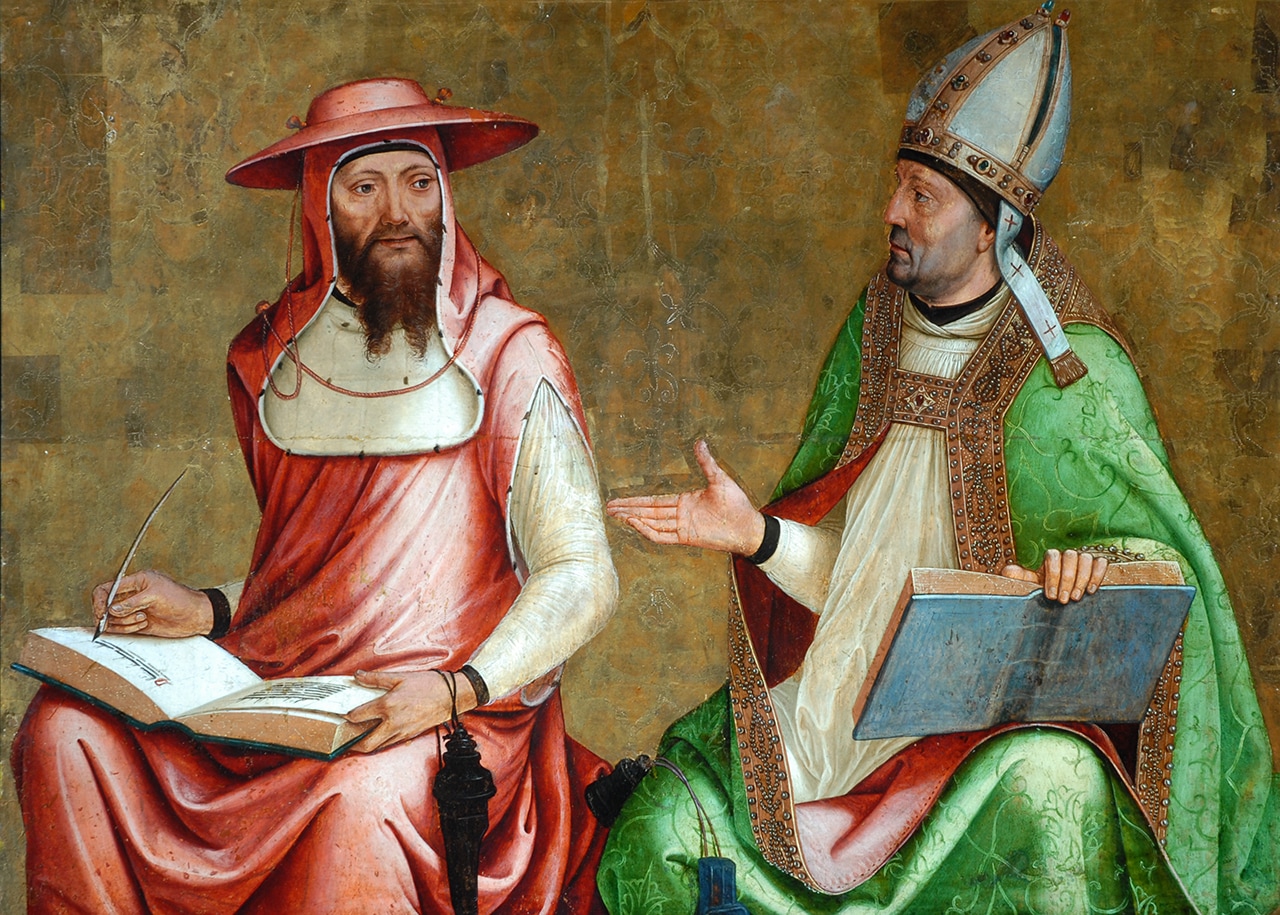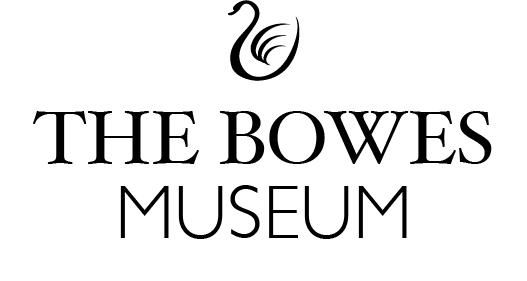

St Gregory and St Augustine & St Jerome and St Ambrose
The peoples of the Middle Ages displayed a particular fondness for questions of structure, system, and order. Having been routinely affected by catastrophic events such as war, plague, and famine, they often sought solace by envisioning themselves as part of a prelapsarian world in which the hand of God could be detected in all that they saw around them. Numbers, in particular, held special power and significance. The four Gospels, produced by the four Evangelists, could be mapped onto the four points of the compass, the four seasons, the four elements, the four winds, the four rivers flowing out of Eden (Genesis 2:10), or even the four garments of Christ (John 19:23). Just as Lazarus spent four days in the tomb before being resurrected back to life (John 11:17), the Four Horsemen of the Apocalypse—countered in turn by the four angels at the four corners of the earth (Revelation 7:1)—evoked a sense of justice, stability, order, and completion, a detail echoed at a more earthly level by the preference for having the most serious criminals hung, drawn, and then quartered.
The Four Doctors of the Western Church fit neatly into this pattern. Expressing a sense of divine order, and of the natural justice and harmony of the afterlife, they are figured in Borgoña’s paintings as the inhabitants of an ethereally beautiful domain, drafting and refining their ideas through a series of debates and discussions that will cease only at the end of time and the pronouncement of the Last Judgement. The dead are characterized in this sense as being significantly more alive than the living, revelling in the order and certainty that was so patently absent from everyday life in the terrestrial domain.
As Bishop of Rome from 590 until his death in 602, St Gregory was a prolific author who reformed the Latin rite and instigated the conversion of the Anglo-Saxons. His name is most commonly associated today with the cadenced polyphony of the Gregorian chant—a form of worship named directly after him. St Ambrose (d. 397), in contrast, served as Bishop of Milan and was renowned for his writings and the eloquence of his preaching, especially in relation to heretical beliefs such as those of the Arians.
The third doctor, St Jerome, fled to the solitude of the desert in the late fourth century before settling in Jerusalem. He is most commonly depicted in Spanish artworks in conjunction with the lion that he tamed, the rock that he used to beat sexual thoughts from his mind (see ‘Suffering and Pain’, 8), and the version of the Bible (the Vulgate) that he translated into Latin. Finally, St Augustine (d. 430) was a theologian and philosopher of Berber origin who served as Bishop of Hippo Regius in Numidia in Roman North Africa. Since his writings are limited mainly to homilies, he is the only one of the four to be depicted without a quill.
Juan de Borgoña is thought to have been born in Burgundy and to have visited Italy, where he worked in the studio of Domenico Ghirlandaio (1448–94) before settling in Toledo. His paintings are most notable for their vivid colours and the skilful depiction of costume.
 Click to zoom and pan
Click to zoom and pan
 Click to zoom and pan
Click to zoom and pan
...
Your feedback is very important to us. Would you like to tell us why?
We will never display your feedback on site - this information is used for research purposes.
Artwork Details
Title
St Gregory and St Augustine.
Artist
Juan de Borgoña (Burgundy, c. 1470 – Toledo, 1536).
Date
c. 1510.
Medium and Support
Tempera and gold on panel.
Dimensions
86 x 118 cm.
Marks and Inscriptions
Inscribed on its cradling: ‘Por Dn Manuel Lopez Gorda 162.60’.
Acquisition Details
Bequeathed by John and Joséphine Bowes, 1885.
Previous Owners
Probably Alejandro Mon; purchased by John and Joséphine Bowes, through Benjamin Gogué, Paris, from the collection of the late Conde de Quinto, 1862, cat. nos. 127 and 128, as by Antonio del Rincón.
Institution
The Bowes Museum, Barnard Castle, B.M.69.
Title
St Jerome and St Ambrose.
Artist
Juan de Borgoña (Burgundy, c. 1470 – Toledo, 1536).
Date
c. 1510.
Medium and Support
Tempera and gold on panel.
Dimensions
87.5 x 120.5 cm.
Marks and Inscriptions
None.
Acquisition Details
Bequeathed by John and Joséphine Bowes, 1885.
Previous Owners
Probably Alejandro Mon; purchased by John and Joséphine Bowes, through Benjamin Gogué, Paris, from the collection of the late Conde de Quinto, 1862, cat. nos. 127 and 128, as by Antonio del Rincón.
Institution
The Bowes Museum, Barnard Castle, B.M.69.
Bibliography
Diego Angulo Iñiguez, Juan de Borgoña, Colección Artes y Artistas (Madrid: Instituto Diego Velázquez del Consejo Superior de Investigaciones Científicas, 1954);
Chandler Rathfon Post, A History of Spanish Painting, IX: The Beginning of the Renaissance in Castile and Leon (Cambridge MA: Harvard University Press, 1947), p. 232;
Juan Antonio Gaya Nuño, La pintura española fuera de España: historia y catálogo (Madrid: Espasa-Calpe, 1958), p. 117 (nos. 398–99);
Eric Young, Four Centuries of Spanish Painting: 17th June – 17th September 1967, The Bowes Museum, Barnard Castle, County Durham (Gateshead: Team Valley Printers, 1967), pp. 18–19 (nos. 12–13);
Eric Young, Catalogue of Spanish Paintings in the Bowes Museum, 2nd ed. (Middlesborough: The Bowes Museum, 1988), pp. 40–43;
Véronique Gerard Powell, ‘Spanish Paintings in the Bowes Museum’, in Spanish Art in County Durham, ed. Clare Baron & Andy Beresford (Bishop Auckland: Auckland Castle Trust, The Bowes Museum, & Durham University, 2014), pp. 60–61;
Mercedes Cerón, ‘Saint Gregory and Saint Augustine’, https://www.vads.ac.uk/digital/collection/NIRP/id/27853/ [accessed: 09.07.22];
Mercedes Cerón, ‘Saint Jerome and Saint Ambrose’, https://www.vads.ac.uk/digital/collection/NIRP/id/28372/ [accessed: 09.07.22].
